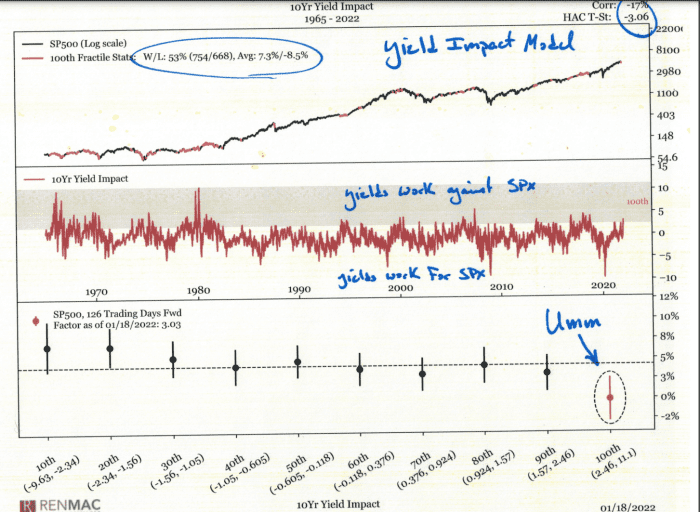This post was originally published on this site
A sharp rise in U.S. Treasury yields so far this year may have further to run, but the speed and scope of the move so far signals that stock market returns in the months ahead could suffer, according to a top Wall Street technical analyst.
“We have found that the current yield as a percentile of its recent range, along with the pace, or rate of change it has shown over the recent path has a big impact on the forward returns” for the S&P 500
SPX,
wrote Jeff deGraaf, founder of Renaissance Macro Research, in a Wednesday note (see chart below).

Renaissance Macro Research
“The lower the level of rates and the faster the collapse in those rates, the better for stocks out [six months] forward. The higher the level and the faster the surge in rates, the worse the returns for the SPX going out 6m,” deGraaf wrote.
With the 10-year yield having broken above resistance at 1.77%, the pace of the advance has pushed RenMac’s yield impact model into its highest historical decile, “and one that pressures forward equity returns historically,” he said, as shown in the bottom third of the chart.
The yield on the benchmark 10-year Treasury note
TMUBMUSD10Y,
edged down Wednesday to trade near 1.859% after trading near 1.9% earlier and hitting its highest since Jan. 8, 2020, during Tuesday trade. The 10-year yield rose nearly 34 basis points, or 0.34 percentage point, in the month to date through Tuesday, its largest jump in the first 11 trading days of a new year since 1982, according to Dow Jones Market Data.
Deep Dive: This is the window of time when value can outperform growth in the stock market
The selloff in Treasurys, pushing debt prices down and yields up, has been blamed on expectations the Federal Reserve will be much more aggressive than previously anticipated in raising interest rates and taking other steps to tighten monetary policy as it responds to persistently high inflation.
See: Fed to use January policy meeting to get ducks in a row for March liftoff
After Tuesday’s selloff, the tech-heavy Nasdaq Composite
COMP,
was down more than 7% so far in the new year, while the S&P 500 declined 4% over the same period and the Dow Jones Industrial Average
DJIA,
was off 2.7%. Stocks were mostly higher Wednesday morning though for the first time in four days.
The sharp rise in yields has been blamed for unsettling equity markets, triggering selling pressure for technology and other growth stocks, in particular. Growth stock valuations are based on expectations for cash flow far into the future. When Treasury yields rise, the value of that future cash is discounted.
Need to Know: Brace for a volatile 2022, but cling to this tech stalwart when the storm comes, says investment adviser
It isn’t necessarily all doom and gloom, however. Analysts at eToro found that stocks tend to have positive returns 12 months after big yield jumps:

